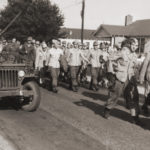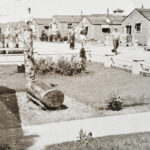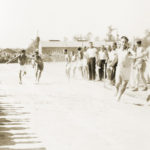German POWs
A couple of years ago I heard a Radiolab podcast titled “Nazi Summer Camp,” and the topic has stayed with me for several reasons. First, I (among many, apparently) was unaware that the United States maintained an extensive network of branch camps for Axis military prisoners of war during WWII. I also couldn’t help but compare the treatment of these POWs with those like my father who were interned in Japanese POW camps during the war. The podcast addresses the Geneva Conventions that dictate treatment of enemy prisoners, a topic I researched for Building for War, and the justifications for keeping – and breaking – Convention rules remain complicated and controversial.
The podcast opens with a reporter’s father recalling Nazi POWs working on his family’s potato farm in Aberdeen, Idaho, during WWII – a fact that surprised the reporter and prompted further investigation. The U. S. Government operated 511 POW camps located in every state in the nation except Vermont. Genealogist and historian Kathy Kirkpatrick states that up to 371,000 Germans, 51,000 Italians, and 5,000 Japanese enemy soldiers were interned in these camps during the war, the largest holding some 8,000 prisoners.
The podcast focuses on one large camp of some 6,000 POWs in little Aliceville, Alabama, which had a population of just 1,500. The first group of a thousand haggard prisoners arrived in mid-1943, captured in the defeat of Rommel’s Afrika Corps and packed into the hold of a cargo ship – with wretched conditions similar to those endured by the captured Wake Islanders who were shipped to Japan in 1942 – for the trip to America. Some were just “whipped kids,” drafted into the German Army against their will, sent far from home to fight, and farther still as prisoners. “Nazi” is too broad a brush for these POWs: many were not members of the Nazi party and had no ideological investment in Hitler’s vision.
As the months went by, more captured Germans swelled the camp. The prisoners were treated well in accordance with the Geneva Conventions, which stipulated that enemy prisoners be given adequate food, clothing, and shelter comparable to a nation’s own troops, and be paid for labor. One survivor recalls that the prisoners set up a school and newspaper, fielded sports teams, had three orchestras, staged theater productions, and held art shows. Working outside the camp as farm labor, they became friends with locals and increasingly assertive in camp. Soon many Americans were protesting that the enemy prisoners had it better than loyal citizens did. In 1944 a congressional investigation into POW “coddling” was held, where an official defended the program by arguing that following the Geneva Conventions would ensure reciprocity for American prisoners captured by enemy nations.
The Geneva Convention of 1929 was signed by most major nations, but required ratification by each to be enforced. The 1929 Convention covered treatment of prisoners of war, while three previous treaties and protocols between 1899 and 1925 set standards for humanitarian treatment of the sick and wounded. (The postwar 1949 Geneva Convention protects against potential breaches of the law by protecting civilian workers and medical personnel not engaged in hostilities and the sick and wounded who are unable to continue fighting.)
My interest in the Geneva Conventions spiked when researching the unprecedented situation of the captured Wake Island civilian workers. I learned that Japan signed but did not ratify the 1929 Convention and thus was not legally bound by it during WWII. However, in 1942 the Japanese Red Cross issued a statement that “we are carrying on relief war prisoners civilian internees according to spirit of Geneva Convention 1929.” At that time the State Department was concerned for American POWs in the absence of any “pertinent international agreement to which both the United States and Japan are parties,” but announced through the International Red Cross that the U. S. Government intended to observe the Geneva Convention “to any civilian enemy aliens that may be interned” and hoped others would reciprocate. Uncertainty over the status of the captured Wake workers (who as civilian internees they would be eligible for repatriation) ended when Japan designated them prisoners of war for their support of military action on Wake Island. Many American prisoners, including my father, were forced to labor in Japan’s war-related industries, despite Convention prohibition of POW work with direct connection to war operations. Many Allied POWs suffered terrible deprivation and punishment in appalling conditions, but if the Geneva standard was conditions comparable to those for a nation’s own troops, one could argue that at least by the end of the war, Japan met that standard. (Building for War, 258-59)
The Radiolab podcast touches on a couple of controversial topics that are relevant to us today: the justifications for application – or not – of the Conventions and the level to which modern interrogation techniques exceed the standards for humane treatment. In a voice clip from a few years ago, Joe Biden states that “there’s a reason we sign these treaties: to protect my son in the military.” To ensure that any captured American soldiers will not be tortured. Even as the full horror of Nazi concentration camps was revealed, the United States stuck to Geneva: we would not “lower ourselves to Nazi standards.” Arguably, the government’s internment of Japanese-American citizens counters that noble commitment, but here the podcast slips into a poorly-supported discussion about regional racism. The point is that in WWII Geneva covered POWs, not civilians or citizens. Fast forward to the 21st century and the new dynamic of global terrorism where Geneva often doesn’t apply, opening the doors to all manner of inhumane treatment. The time for a “civilized” rulebook of war may be over.
See also:
Aliceville Museum
The Geneva Conventions
Arnold Krammer, Nazi Prisoners of War in America (Scarborough House, 1996)
- photo credit Aliceville Museum
- photo credit Aliceville Museum
- photo credit Aliceville Museum




